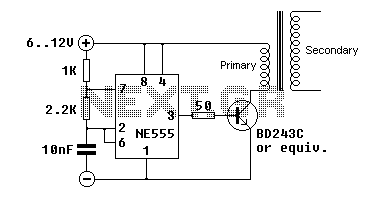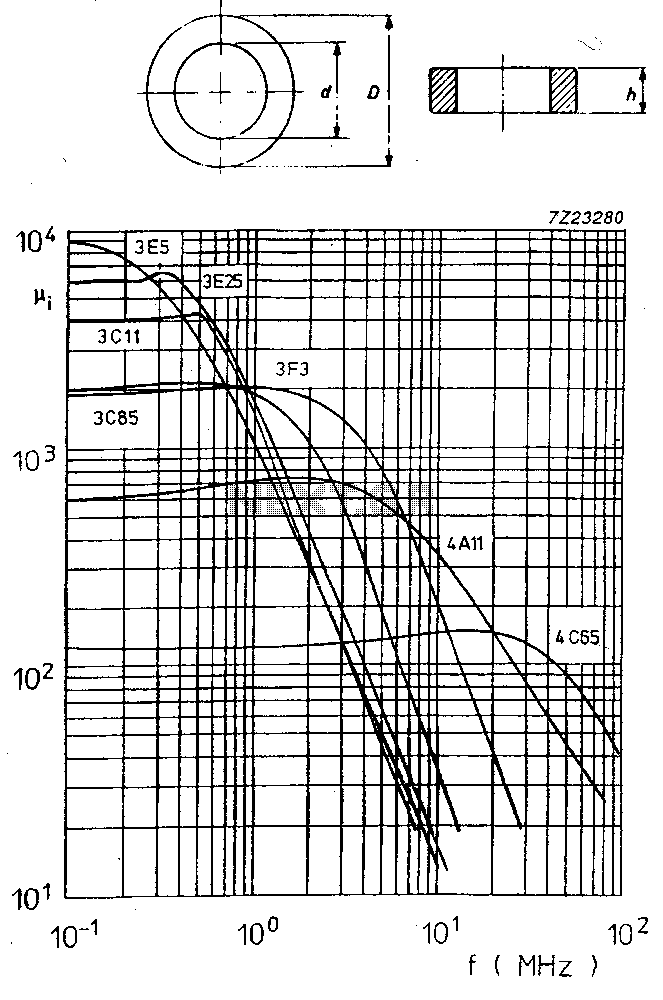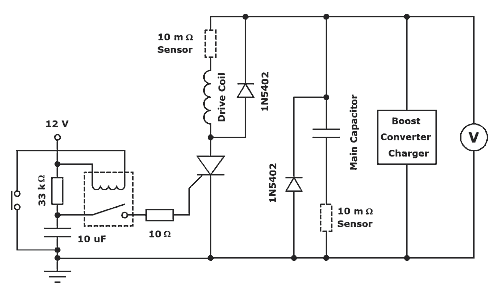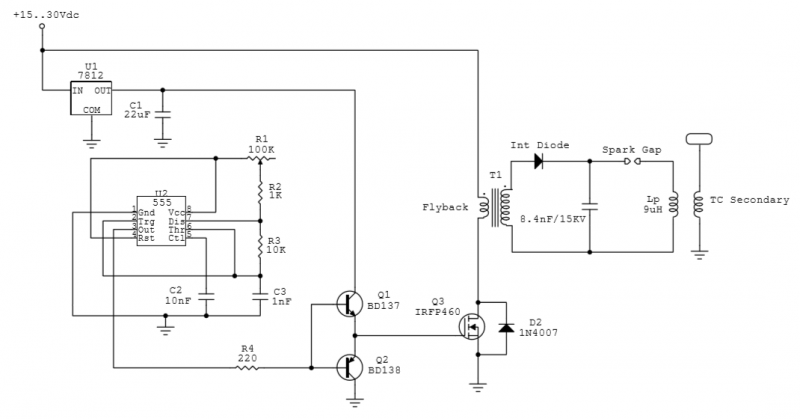
Tesla Coil
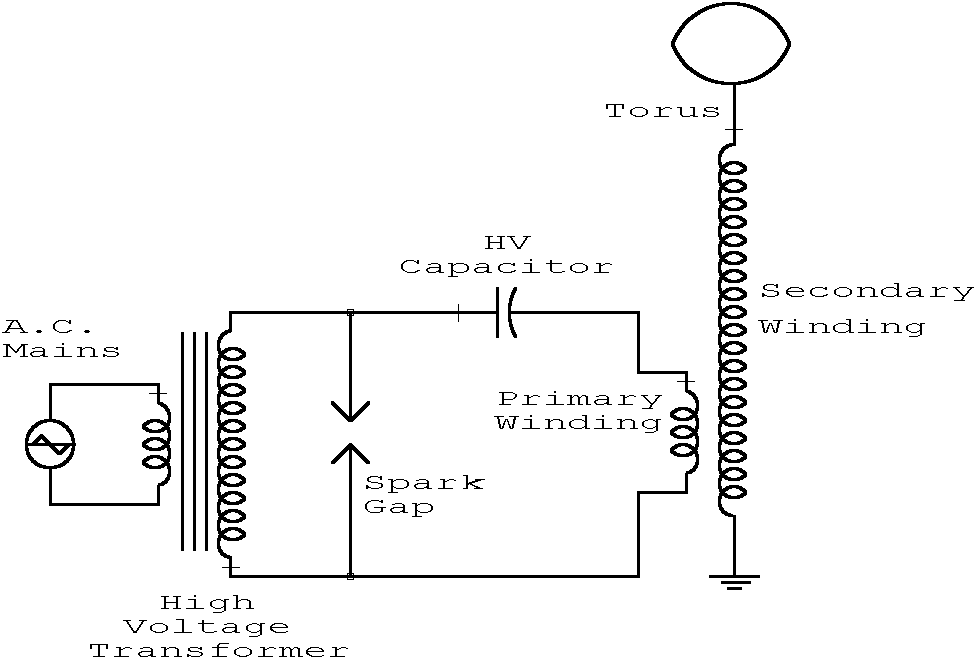
This webpage is designed to provide assistance and information for individuals interested in constructing a Tesla coil. It is recommended to utilize the additional resources available on this page. The electrical line voltage standard in the United States is 120V at 60Hz. However, once past the high voltage transformer, the principles remain largely consistent. All measurements provided are in inches, but they can be easily converted to centimeters. The Tesla coil created will ultimately reflect the builder's personal expression, incorporating information and techniques gathered from this and other resources. Many existing Tesla coil tutorials offer only a fraction of the necessary information or present overly technical details that can overwhelm the builder. Basic woodworking and soldering skills are sufficient to undertake this project. Exact measurements will not be provided to encourage creativity in design and solutions. A comprehensive tutorial will be offered that, if followed closely, will result in a successful Tesla coil. The construction process involves many details, so it is advisable to focus on one part at a time. If the builder lacks the necessary skills or tools, assistance may be sought from knowledgeable individuals, such as teachers or relatives. An article by Hank Mills will serve as an introduction to the basics of Tesla coils, which is accessible to most readers. Interest in Tesla coils is growing due to their fascinating properties, such as producing longitudinal impulses that can transmit power and information through solid containers (Faraday cages), traveling long distances without intensity loss, and achieving overunity energy gains. Simple Tesla coil setups can yield experiments that intrigue even the most skeptical individuals. These properties are established facts, confirmed by numerous researchers, engineers, and scientists worldwide, including Prof. Konstantin Meyl from the University of Applied Sciences in Furtwangen, Germany, who has validated these claims through experimentation and published works. Eric Dollard, an expert in electronics, antenna design, and radio, has also built many systems utilizing Tesla's technology and verified Tesla's assertions. Building a Tesla coil does not require genius; rather, it necessitates a willingness to research, learn, and prioritize safety. This document aims to provide an overview of Tesla coils, their components, construction, and unique properties, with a special emphasis on Steve Jackson's open-sourced Tesla coil plans available at PESWiki. By the conclusion of this document, the reader should have a solid understanding of what is involved in building a Tesla coil. Over a century ago, Nikola Tesla discovered that opening or closing a high voltage circuit generates a brief pulse of high voltage.
The construction of a Tesla coil involves several critical components, each serving a specific purpose in the overall operation of the device. The main components include a power supply, a transformer, a primary coil, a secondary coil, a spark gap, and a capacitor.
The power supply typically consists of a high-voltage transformer, which steps up the voltage from the standard electrical line voltage. In the United States, this is usually 120V at 60Hz. The transformer converts this low voltage to a much higher voltage, often in the range of several kilovolts, necessary for the operation of the Tesla coil.
The primary coil is usually made of thick copper wire and is connected to the capacitor, which stores electrical energy. When the capacitor discharges, it releases a burst of energy into the primary coil, creating a magnetic field. This magnetic field induces a current in the secondary coil, which is typically composed of a larger number of turns of thinner wire. The secondary coil is designed to resonate at a specific frequency, amplifying the voltage generated in the primary coil.
The spark gap acts as a switch that allows the current to flow from the capacitor into the primary coil. When the voltage across the spark gap exceeds a certain threshold, it ionizes the air between the electrodes, allowing the current to flow. This process creates a resonant circuit that generates high-voltage pulses.
Safety precautions are paramount when constructing and operating a Tesla coil. High voltages present significant risks, including electric shock and fire hazards. Proper insulation, grounding, and protective equipment should be used throughout the construction and operation phases. Additionally, it is advisable to work in a controlled environment, away from flammable materials and with adequate ventilation.
In summary, constructing a Tesla coil is a rewarding project that combines creativity and technical skill. By understanding the components and their functions, along with adhering to safety protocols, individuals can successfully build and experiment with Tesla coils, exploring their fascinating electrical properties.This web page is provided to offer assistance and information to anyone that is wanting to construct a Tesla coil. I encourage you to make use of the other resources we offer on this page. I live in the United States, and in this country the electrical line voltage standard is 120V at 60Hz.
However, once you are passed the high voltage transformer , it is all pretty much the same. All of my measurements are in inches, but those can easily be converted to centimeters. Your Tesla coil will ultimately be an expression of you and the finished product will reflect information and techniques you have gathered not only from this page but perhaps from many others. Most of the tesla tutorials I find out there only provide a fraction of the information you really need to build your coil.
Or the information is way to technical and one gets lost in a see of numbers and calculations. Feeling overwhelmed can be one`s greatest stumbling block to building a Tesla coil. As long as you have some general woodworking and soldering skills, you can do it! I do not plan to include exact measurements of everything, as I wish to leave some creative effort to the builder to come up with his or her own solutions and designs. I will do my best to offer a comprehensive tutorial that if followed precisely, will render a very nice Tesla Coil.
There are many details involved to having a finished tesla coil, so just start on one part and continue step by step and you will be successful. If you don`t have the skills or tools yourself to build a Tesla coil, perhaps there is someone (maybe a teacher or relative) who does and would be happy to assist in the construction.
I decided to use this article by Hank Mills as an introduction to my presentation. It really lays out Tesla coil basics in a way that I believe most people will be able to understand. I hope you enjoy reading it. More and more people are becoming interested in Tesla Coils these days. This makes sense, because there are many reasons to be fascinated with them. These systems can produce "longitudinal" impulses that can transmit power and information through solid metal containers (Faraday cages), travel long distances without any drop of intensity, and produce "overunity" gains of energy. With a simple set of Tesla Coils, you can perform experiments that will perplex even the most skeptical folks you may run into!
To be clear, these exotic properties of Tesla Coils are not myth, but established facts that have been replicated countless times by researchers, engineers, and scientists around the world. One such scientist is Prof. Konstantin Meyl from the University of Applied Sciences in Furtwangen, Germany. He has experimentally confirmed the above mentioned properties of Tesla Coils, and has demonstrated his setups many times.
Additionally, he has published a number of books and papers detailing how they work. Another researcher in the field of Tesla Coils is Eric Dollard, an absolute expert in the fields of electronics, antenna design, and radio. He built many systems utilizing Tesla`s technology, and has verified Tesla`s claims. You do not have to be a genius to build a Tesla Coil. They are fairly simple devices. What is required is the willingness to do research, the ability to learn, and the common sense to take all proper safety measures.
Safety must always be a priority! The purpose of this document is to give an overview of Tesla Coils, their components, their construction, and their special properties. A special emphasis will be placed on Steve Jackson`s Tesla Coil plans that have been open sourced at PESWiki.
By the time you have finished reading this document, it is hoped you will have a very good idea about what is involved in building a Tesla Coil Over a hundred years ago, Nikola Tesla discovered that when a high voltage circuit is opened or closed, a brief pulse of high voltage is created. In his age, these pulses of high v 🔗 External reference
The construction of a Tesla coil involves several critical components, each serving a specific purpose in the overall operation of the device. The main components include a power supply, a transformer, a primary coil, a secondary coil, a spark gap, and a capacitor.
The power supply typically consists of a high-voltage transformer, which steps up the voltage from the standard electrical line voltage. In the United States, this is usually 120V at 60Hz. The transformer converts this low voltage to a much higher voltage, often in the range of several kilovolts, necessary for the operation of the Tesla coil.
The primary coil is usually made of thick copper wire and is connected to the capacitor, which stores electrical energy. When the capacitor discharges, it releases a burst of energy into the primary coil, creating a magnetic field. This magnetic field induces a current in the secondary coil, which is typically composed of a larger number of turns of thinner wire. The secondary coil is designed to resonate at a specific frequency, amplifying the voltage generated in the primary coil.
The spark gap acts as a switch that allows the current to flow from the capacitor into the primary coil. When the voltage across the spark gap exceeds a certain threshold, it ionizes the air between the electrodes, allowing the current to flow. This process creates a resonant circuit that generates high-voltage pulses.
Safety precautions are paramount when constructing and operating a Tesla coil. High voltages present significant risks, including electric shock and fire hazards. Proper insulation, grounding, and protective equipment should be used throughout the construction and operation phases. Additionally, it is advisable to work in a controlled environment, away from flammable materials and with adequate ventilation.
In summary, constructing a Tesla coil is a rewarding project that combines creativity and technical skill. By understanding the components and their functions, along with adhering to safety protocols, individuals can successfully build and experiment with Tesla coils, exploring their fascinating electrical properties.This web page is provided to offer assistance and information to anyone that is wanting to construct a Tesla coil. I encourage you to make use of the other resources we offer on this page. I live in the United States, and in this country the electrical line voltage standard is 120V at 60Hz.
However, once you are passed the high voltage transformer , it is all pretty much the same. All of my measurements are in inches, but those can easily be converted to centimeters. Your Tesla coil will ultimately be an expression of you and the finished product will reflect information and techniques you have gathered not only from this page but perhaps from many others. Most of the tesla tutorials I find out there only provide a fraction of the information you really need to build your coil.
Or the information is way to technical and one gets lost in a see of numbers and calculations. Feeling overwhelmed can be one`s greatest stumbling block to building a Tesla coil. As long as you have some general woodworking and soldering skills, you can do it! I do not plan to include exact measurements of everything, as I wish to leave some creative effort to the builder to come up with his or her own solutions and designs. I will do my best to offer a comprehensive tutorial that if followed precisely, will render a very nice Tesla Coil.
There are many details involved to having a finished tesla coil, so just start on one part and continue step by step and you will be successful. If you don`t have the skills or tools yourself to build a Tesla coil, perhaps there is someone (maybe a teacher or relative) who does and would be happy to assist in the construction.
I decided to use this article by Hank Mills as an introduction to my presentation. It really lays out Tesla coil basics in a way that I believe most people will be able to understand. I hope you enjoy reading it. More and more people are becoming interested in Tesla Coils these days. This makes sense, because there are many reasons to be fascinated with them. These systems can produce "longitudinal" impulses that can transmit power and information through solid metal containers (Faraday cages), travel long distances without any drop of intensity, and produce "overunity" gains of energy. With a simple set of Tesla Coils, you can perform experiments that will perplex even the most skeptical folks you may run into!
To be clear, these exotic properties of Tesla Coils are not myth, but established facts that have been replicated countless times by researchers, engineers, and scientists around the world. One such scientist is Prof. Konstantin Meyl from the University of Applied Sciences in Furtwangen, Germany. He has experimentally confirmed the above mentioned properties of Tesla Coils, and has demonstrated his setups many times.
Additionally, he has published a number of books and papers detailing how they work. Another researcher in the field of Tesla Coils is Eric Dollard, an absolute expert in the fields of electronics, antenna design, and radio. He built many systems utilizing Tesla`s technology, and has verified Tesla`s claims. You do not have to be a genius to build a Tesla Coil. They are fairly simple devices. What is required is the willingness to do research, the ability to learn, and the common sense to take all proper safety measures.
Safety must always be a priority! The purpose of this document is to give an overview of Tesla Coils, their components, their construction, and their special properties. A special emphasis will be placed on Steve Jackson`s Tesla Coil plans that have been open sourced at PESWiki.
By the time you have finished reading this document, it is hoped you will have a very good idea about what is involved in building a Tesla Coil Over a hundred years ago, Nikola Tesla discovered that when a high voltage circuit is opened or closed, a brief pulse of high voltage is created. In his age, these pulses of high v 🔗 External reference
